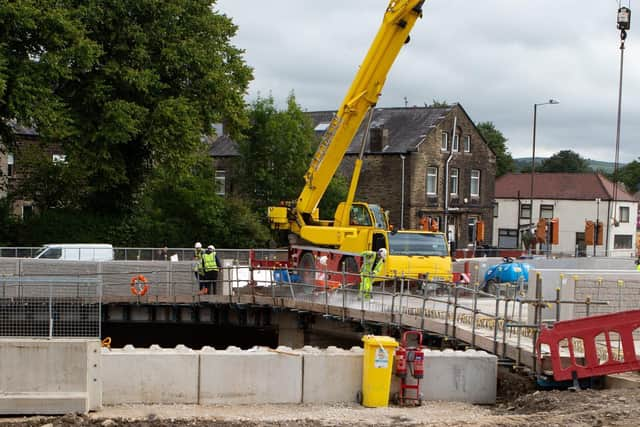Huge strides being made in protecting Calderdale from future floods
and live on Freeview channel 276
The Calderdale Flood Recovery and Resilience Board, which was set up in the aftermath of the 2012 floods, reviewed the progress made and discussed the next phases of the programme, which will continue to build resilience across the Calder Valley.
Leader of Calderdale Council and Chair of the Calderdale Flood Recovery and Resilience Board, Councillor Tim Swift said: “As we reach the anniversary of the Boxing Day floods, I’d like to thank all of the people and partners who are working hard to keep our communities safe.
Advertisement
Hide AdAdvertisement
Hide Ad“We know a huge amount is done by unpaid volunteers, who are unsung heroes within all of our towns and villages, and we’re extremely grateful for their commitment.


“We also recognise and appreciate the patience of those who are living with the everyday disruption as the work on our flood alleviation schemes continues.
“These will ultimately provide a greater degree of protection in the future.
“It’s important to remember however, that because of our steep-sided valley and the impact of climate change, we will always be at risk of flooding, so I’d urge everyone to prepare carefully so that they and their property are protected.”
Advertisement
Hide AdAdvertisement
Hide AdYorkshire Water, working in partnership with Calderdale Council and the Environment Agency, will be carrying out a second trial which will reduce water levels by up to 10 per ccent at reservoirs on Hebden Water over the coming winter.
This will provide extra storage for flood water, carefully balancing flood risk against the demand for public water supplies.
Yorkshire Water’s Chief Strategy and Regulation Officer, Nevil Muncaster said: “Lowering reservoirs is not a silver bullet solution to preventing flooding and all agencies need to work together on a wide range of measure to reduce risk, but the data suggests that it could have a positive impact, so it is important that we continue to work to understand both the benefits and potential implications for water resources in the region.
“We’re committed to continuing to work in partnership with others to help reduce flood risk in Calderdale.”
Advertisement
Hide AdAdvertisement
Hide AdPaul Swales, Environment Agency Flood Risk Advisor, said: “Great progress has been made on the Mytholmroyd flood alleviation scheme which will better protect 400 homes and businesses.
“The project is really beginning to change the appearance of the village with the new, widened bridge due to be opened in spring 2020 and many of the new walls completed.
“The project continues to be delivered at pace following the government commitment made after the Boxing Day 2015 floods and is due for completion in late summer 2020.
“In addition, major schemes continue to be developed, designed and planned to better protect communities within the Calder Valley, including Hebden Bridge and Brighouse.”
Advertisement
Hide AdAdvertisement
Hide AdThe Council has said that if everyone plays their part in preparing for and helping to reduce the impacts of severe weather, they are helping to build Calderdale’s resilience – one of the key themes of the Vision2024 for Calderdale.
Highlights of the progress which has been made since the 2015 floods under the four themes of the Calderdale Flood Action Plan include:
Strengthening Defences
The Mytholmroyd Flood Alleviation Scheme is on track for completion in summer 2020 with further major schemes in development at Hebden Bridge and Brighouse.
Six Flood Risk Reduction Schemes (FRRS) have been completed and several more are in progress to give important drainage and other flood relief measures in key locations.
Advertisement
Hide AdAdvertisement
Hide AdWork continues to identify and manage flood risk assets and promote the implementation of more sustainable drainage along with the effective maintenance of watercourses.
Partners working together under this theme are continually seeking new investment to fund the ambitious range of works across the Plan.
Natural Flood Management (NFM)
Modelling studies are building our understanding of current land management impacts on flooding and informing the strategic priorities for NFM.
Community organisations and volunteers are delivering NFM interventions in partnership to slow the flow of water from the uplands to the valley bottoms.
Advertisement
Hide AdAdvertisement
Hide AdA strategy has been produced to engage landowners and promote the use of NFM techniques, along with a grant scheme and guidance for farmers.
Work continues to secure support for future payment of landowners and assess habitat regulations of emerging Local Plan policies.
Resilient infrastructure
After the 2015 floods, many highways, bridges, public footpaths and reservoirs were inspected and repaired, and many damaged substations were repaired and replaced.
Now actions within this section are focussed on maintaining and improving the resilience of infrastructure including electricity substations, transport infrastructure and water systems.
Advertisement
Hide AdAdvertisement
Hide AdInvestigations have been undertaken to identify issues from potential future landslips and damage to flood risk assets.
Ongoing work is addressing the need to facilitate better information sharing with the wider community.
Community resilience
After the flooding, grants were administered to homes and businesses and support was provided to local charities, volunteer flood groups and flood warden networks.
Flood Groups have continued to grow and thrive, expanding range , membership, and equipment storage.
Advertisement
Hide AdAdvertisement
Hide AdEngagement and communications continue with local householders, businesses and schools to raise awareness of flood risk and support preparedness.
Regular flood exercises and siren tests have assessed the response of partners and the community to flooding.
Delivery of mental health support is ongoing to help those affected by flooding.